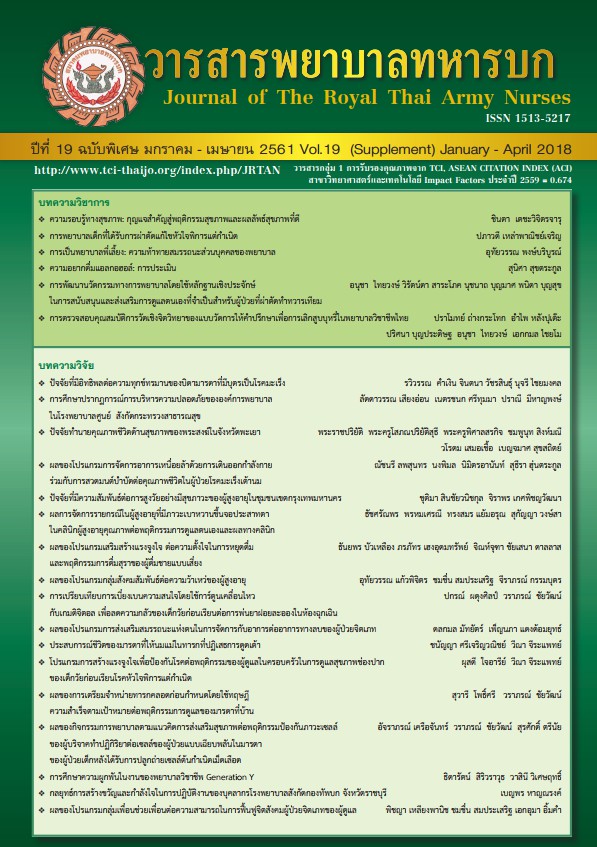Nursing Care of Children Undergoing Congenital Heart Surgery
Keywords:
Congenital Heart Disease, Congenital Heart Surgery, Cardioplegia Needle’s guard, Nursing careAbstract
Congenital Heart Disease is a disease of the infant developmental abnormalities in the fetus and death or disability. This type of congenital heart disease can be treated with surgery to correct the defect, reduce child mortality. The treatment needs to be treated by specialist surgeon (Cardiovascular Thoracic surgeon) is to consider whether or not to have surgery. Choose when and how the individual child so that the effect of the surgery is safe and complications minimal under the collaboration of multidisciplinary. The operative nurses are responsible for not only preparing equipment for surgery, but also providing care during preoperative, intraoperative and postoperative care to promote safety and comfort of children. Surgical correction of congenital heart that causes the heart to stop beating requires materials in which the heart stops was “Cardioplegia Needle’s guard” will be applied for surgical technique
Downloads
References
2. Pillitteri, A. Maternal & child health nursing: care of the childbearing & childrearing family. (6th ed). China: Wolters Kluwer. 2010.
3. David Barrett, Mark Gretton and Tom Quinn. Congenital heart disease. Cardiac care: An Introduction for Healthcare Professional.. John Wiley & Sons Ltd. 2006; 144-154.
4. Siriboonpipat P. Nursing Children 2. (1st ed). Bangkok: Thanapress Co., Ltd. 2012. (in Thai) 5. Rudolph, C.D., et al. Rudolph’s pediatrics. (21st
ed.). New York: McGraw-Hill, Inc. 2002.
6. Allen, P.J., Vessey, J.A., & Schapiro, N.A. Primary care of the child with a chronic condition. (5th ed.). United States of America: Mosby Elsevier. 2010.
7. Magarapong P. & Kongpatanayochin A. Pediatric Heart Surgery. Pediatric cardiac critical care. Bangkok: Amarin Printing & Publishing Co., Ltd.
2008; 227-233. (in Thai)
8. Grady L., Denton A., & Howard P. Cannulation and Perfusion. Surgical Treatment of Congenital Heart Disease. Philadelphia: Lea & Febiger. 1987; 3-13.
9. Tea C. Perioperative nursing management. In S.C. Smeltzer, B. G. Bare, J. L. Hinkle, & K. H. Cheever (Eds.), Burnner & Suddarth’s textbook of medical-surgical nursing. Philadephia: Lippincott William & Wilkins. 2010.
10. Ferrari L. R., Rooney F. M., & Rockoff M. A. Preoperative fasting practices in pediatrics. Anesthesiology. 1999; 90 (4): 978-980.
11. Engineering Institute of Thailand. Air Conditioning and Ventilation Standard. (1st ed). 2008; 51. (in Thai)
12. CDC. Guidelines for Environment Infection Control in Health Care Facilities. 2003; 7.
13. Washiratanakorn S. & Shukit S. Effects of nursing practice for neonatal hypothermia prevention in Cesareansection. Perioperative nursing care
conference 2nd. The Thai Perioperative Nurses Association at International Trade & Exhibition Centre: BITEC. Bangkok: N P Press. 2008; 44.
(in Thai)
14. Luginbuehl I., & Bissonnette B. Thermal regulation. In C. J. Cote J. Lerman & I. D. Todres (Eds.). A practice of anesthesia for infants and
children. Philadelphia: Saunder. 2009; 557-565.
15. Musiksukon S. & et.al. Nursing care in children and adolescents of cardiovascular disorder. Nursing Pediatric Textbook. (2nd ed). Bangkok:
Preonelimitedparthership 2012; 69-78. (in Thai)
16. Splinter W. M., & Schreiner M. S. Preoperative fasting in children. Anesthesia & Analgesia. 1999; 89 (1): 80-89.
Downloads
Published
How to Cite
Issue
Section
License
บทความหรือข้อคิดเห็นใดใดที่ปรากฏในวารสารพยาบาลทหารบกเป็นวรรณกรรมของผู้เขียน ซึ่งบรรณาธิการหรือสมาคมพยาบาลทหารบก ไม่จำเป็นต้องเห็นด้วย
บทความที่ได้รับการตีพิมพ์เป็นลิขสิทธิ์ของวารสารพยาบาลทหารบก
The ideas and opinions expressed in the Journal of The Royal Thai Army Nurses are those of the authors and not necessarily those
of the editor or Royal Thai Army Nurses Association.






